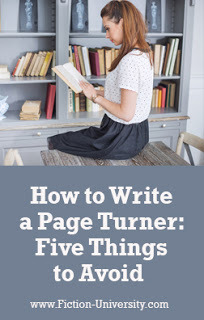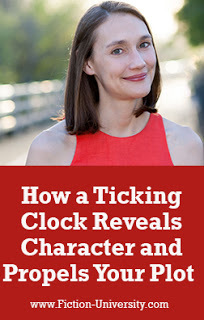Janice Hardy's Blog, page 76
May 7, 2019
How to Write A Real-Page Turner, Part 2: Five Things to Avoid
 By Laurisa White Reyes, @lwreyes
By Laurisa White Reyes, @lwreyesPart of the How They Do It Series
JH: Laurisa White Reyes continues her How to Write a Page-Turner series today with five things that will make readers not want to turn the page.
The sub-title of this post is “5 Sure Fire Fun-Suckers.” This is what my son calls books that are too boring to read all the way through. You know what I’m talking about—those books you started with good intentions only to lose interest part way and consign them to the abyss of novels unfinished.
As authors, we don’t want our books to be boring. We want readers to feel excited about our stories, to keep turning those pages. So, what can we do to make our books real page-turners? Well, first we should know what NOT to do.
Continue ReadingWritten by Janice Hardy. Fiction-University.com

Published on May 07, 2019 03:00
May 3, 2019
The Art of Juggling Multiple Writing Projects
 By Swati Teerdhala, @swatiteerdhala
By Swati Teerdhala, @swatiteerdhalaPart of The Writer's Life Series
JH: It takes skill to juggle several writing projects at once, and sometimes, we need a little help to avoid dropping one of them. Swati Teerdhala returns to the podium today to share tips on writing multiple projects at once.
Swati Teerdhala is the author of the upcoming novel, THE TIGER AT MIDNIGHT, the first in a trilogy. After graduating from the University of Virginia with a B.S. in Finance and History, she tumbled into the marketing side of the technology industry. She’s passionate about many things, including how to make a proper cup of chai, the right ratio of curd-to-crust in a lemon tart, and diverse representation in the stories we tell. She currently lives in New York City and can be found wandering the streets with a pen or camera in hand.
Instagram | Website | Twitter
Take it away Swati…
Continue ReadingWritten by Janice Hardy. Fiction-University.com

Published on May 03, 2019 05:08
May 2, 2019
The Best Time to Write
 By Shanna Swendson, @ShannaSwendson
By Shanna Swendson, @ShannaSwendsonPart of The Writer’s Life Series
JH: Just finding time to write can be a hassle without trying to figure out the “best” time to do it. Luckily, Shanna Swendson takes the podium today to share tips on finding the best time to write that works for you.
Shanna Swendson earned a journalism degree from the University of Texas but decided it was more fun to make up the people she wrote about and became a novelist. She’s written a number of fantasy novels for teens and adults, including the Enchanted, Inc. series and the Rebel Mechanics series. She devotes her spare time to reading, knitting, and music.
Website | Twitter | Facebook | Goodreads
Take it away Shanna…
Continue ReadingWritten by Janice Hardy. Fiction-University.com

Published on May 02, 2019 05:13
May 1, 2019
Bob and Weave: How to Mix Character Actions and Internal Thoughts
 By Janice Hardy, @Janice_Hardy
By Janice Hardy, @Janice_Hardy It's been one of those weeks, so here's a heavily updated oldie but goody from the archives on weaving internal thoughts into character action. Enjoy!
Although some scenes (and some writers) find the perfect balance between action and internal thought with ease, other scenes take work to get that balance right. Tip the balance too far in either direction, and the writing can come across as too slow (too much in a character's head) or too flat (all description, no character).
There's no rule or ratio for this, and a writer's voice grows from how (s)he strings words together. A combination that works in one where what the character does flows smoothly with what the character thinks, and thoughts and actions work in tandem to tell the story. A more thoughtful novel will likely tip to the internal thought side, while a thriller might lean toward the action.
Continue ReadingWritten by Janice Hardy. Fiction-University.com

Published on May 01, 2019 03:30
April 30, 2019
How a Ticking Clock Reveals Character and Propels Your Plot
 By Sarah Skilton, @Sarah_Skilton
By Sarah Skilton, @Sarah_SkiltonPart of the How They Do It Series
JH: There’s no greater motivator than a hard deadline (right writers?), and that’s just as true for our characters. Today, Sarah Skilton visits the lecture hall to share some tips on using a ticking clock to keep your plot and characters moving.
Sarah Skilton is a book blogger with Barnes & Noble as well as the author of two young adult novels, Bruised and High & Dry . Her first adult novel, Club Deception , was published by Grand Central in 2017. Last year she participated as a judge on the juvenile committee for the 2019 Edgar Awards.
Website | Goodreads | Facebook | Twitter | Instagram|
Take it away Sarah…
Continue ReadingWritten by Janice Hardy. Fiction-University.com

Published on April 30, 2019 03:50
April 28, 2019
Sunday Writing Tip: Examine Your Turning Points
 By Janice Hardy, @Janice_Hardy
By Janice Hardy, @Janice_Hardy Each week, I’ll offer a tip you can take and apply to your WIP to help improve it. They’ll be easy to do and shouldn’t take long, so they’ll be tips you can do without taking up your Sunday. Though I do reserve the right to offer a good tip now and then that will take longer—but only because it would apply to the entire manuscript.
This week, look at each major turning point in your plot and make sure it advances the story the way you want it to.
While it’s okay to ignore structure and even plot in a first draft, on draft two, you really need to start nailing down what the plot is and how it unfolds. It’s not uncommon to discover the first draft wanders a bit and doesn’t hit the plot marks it ought to for the strongest story and pacing.
Identify your major turning points and make sure they’re building upon each other to form the plot. What structure you use is up to you, as is what specific points you choose, but every story is going to have a beginning—middle—ending, which means problem discovered—attempt to solve problem—resolution to problem.
Continue ReadingWritten by Janice Hardy. Fiction-University.com

Published on April 28, 2019 05:42
April 27, 2019
Real Life Diagnostics: Does This Scene Keep Readers Interested?
 Critique By Maria D'Marco
Critique By Maria D'MarcoReal Life Diagnostics is a weekly column that studies a snippet of a work in progress for specific issues. Readers are encouraged to send in work with questions, and we diagnose it on the site. It’s part critique, part example, and designed to help the submitter as well as anyone else having a similar problem.
If you're interested in submitting to Real Life Diagnostics, please check out these guidelines.
Submissions currently in the queue: Three
Please Note: As of today, RLD slots are booked through May 18.
This week’s questions:
1. Is there telling, instead of showing?
2. Backstory present? (My first line indicates backstory but am wondering if it’s okay, since it’s a bit of a hook. Suggestions appreciated.)
3. Does this scene work? Makes sense, flow well, keep reader interest?
Market/Genre: Inspirational Romantic Suspense
This is a resubmit so check out the original if you'd like to see how the writer revised.
On to the diagnosis…
Continue ReadingWritten by Janice Hardy. Fiction-University.com

Published on April 27, 2019 04:58
April 26, 2019
Assessing Yourself as a Writer: Does Your Writing Make the Grade?
 By Joyce Sweeney
By Joyce Sweeney Part of The Writer’s Life Series
JH: It's not always clear to know what to focus on to improve our writing, but Joyce Sweeney has a formula to help writers grade their stories. Please give her a warm welcome.
Joyce Sweeney is the author of fourteen novels for young adults and two chapbooks of poetry. Her books have won many awards and honors. Joyce has recently switched to writing adult fiction and is represented by Nicole Resciniti of the Seymour agency.
Joyce has also been a writing teacher and coach for 25 years and offers online classes. In 2019, she, Jamie Morris and Tia Levings released Plotting Your Novel with The Plot Clock (Giantess Press). At this writing, 62 of Joyce’s students have successfully obtained traditional publishing contracts.
Joyce lives in Coral Springs with her husband, Jay and caffeine-addicted cat, Nitro.
Take it away Joyce…
Continue ReadingWritten by Janice Hardy. Fiction-University.com

Published on April 26, 2019 04:39
April 25, 2019
Writing to Heal: The Benefits of a Cathartic Novel
 By Kassandra Lamb, @KassandraLamb
By Kassandra Lamb, @KassandraLambPart of The Writer’s Life Series
JH: Writing has many benefits, and the chance to sort through difficult emotions is one of them. Kassandra Lambs visits the lecture hall today to share thoughts on how writing a cathartic novel can help a writer heal.
Kassandra Lamb is a retired psychotherapist/college professor turned mystery writer. She spends most of her time with her characters in an alternate universe, the magic portal to which (i.e., her computer) is located in Florida, where her husband and dog catch occasional glimpses of her.
She is the author of the Kate Huntington mystery series, The Kate on Vacation novellas, and the Marcia Banks and Buddy cozy mysteries, plus a guidebook for novice writers, Someday Is Here! A Beginner’s Guide to Writing and Publishing Your First Book . She also writes romantic suspense under the pen name Jessica Dale.
Website | Goodreads | Facebook | Twitter |
Take it away Kassandra…
Continue ReadingWritten by Janice Hardy. Fiction-University.com

Published on April 25, 2019 05:16
April 24, 2019
6 Tips on Making Similar Scenes Feel Different
 By Janice Hardy, @Janice_Hardy
By Janice Hardy, @Janice_Hardy Novels often use similar scenes to tell a story, but writers don't have to make them all read the same. Here's a look back on ways to keep scenes from feeling repetitive.
Novels—especially genre novels—often have similar scenes making up the plot, because the protagonist has a series of tasks to complete in pursuit of the goal. In a pulse-racing thriller, the protagonist will find himself involved in action sequences or chase scenes. Romance heroes and heroines will navigate their way through a lot of relationship scenes. Sleuths in mysteries will spend a large chunk of the story searching for clues and speaking with suspects. After a while, these similar scenes can feel repetitive and even predictable.
For example, if there are a lot of chase scenes where the protagonist (or antagonist) is never caught, readers might just assume she won't be and stop worrying about it. Lovers who almost kiss over and over? They won't be the only ones frustrated by the repeated near-misses. But these core scenes are central to these novels, and are even expected by their readers.
Continue ReadingWritten by Janice Hardy. Fiction-University.com

Published on April 24, 2019 03:30



